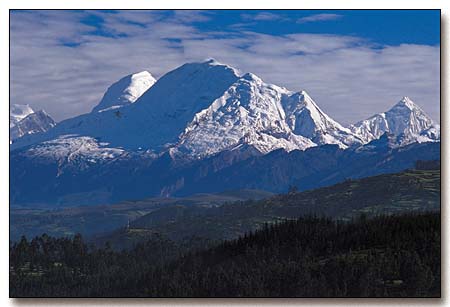When I got to Terminal Terrestre in Loja to catch the bus to Piura Ecuador played football agaist Mexico. The match was on all screens, everyone was watching it, and when Ecuador won everyone got crazy.
The border crossing between Loja and Piura is really relaxed. After a few hours of the ride, the bus was stopped by men in uniforms. Everyone had to get off the bus and showed a passport. I thought it was the Ecuadorian side of the border, but it turned out to be just some checking point. The border crossing was one hour later. On the Ecuadorian side, I had to show my passport and fill out a form that everyone already had and I didn't. On the Peruvian side, I had to fill out a bit longer form, but didn't have any complications, and was granted 90 days. We had to walk between both sides, the bus was waiting for us behind the Peruvian customs office. In Peru, there was one checking point one hour after the border, too. This time, they checked baggage.
When I arrived to Piura I had to look for connections. I was going to take a bus to Lima, but found out it didn't have any connection to Huaraz. There were just two more gringos on the bus. One of them helped me a lot. It was Yuri from Russia who currently lives in Argentina and speaks Spanish fluently. He offered me to share a cab to one of the bus companies which provide buses to the south. In Peru, it's a bit more complicated than in Ecuador. Every company has its own bus station and provides buses just to certain destinations. So if you want to make a connection you may have to go across the whole city. I needed to get to Trujillo, but the company, we'd gone to, had buses to Trujillo too late that day. Yuri asked someone and got a directions to a company which provided buses to Chiclayo from where buses often go to Trujillo. Because he had nothing to do he walked with me to the bus station. I read some commentaries of people who said the part of Piura we were in was the worst place they'd seen in Peru. It wasn't a pleasant place, but we didn't find it extraordinary dangerous.
In Chiclayo, I had to go across the whole city to get on the connection to Trujillo. At least, the cab drivers are acknowledged and if you tell them your destination they take you to the right station. There are usually 8-10 of them in every bigger city.
Peruvian buses have several levels of comfort. The best ones are far better than buses of Student Agency. Seats in them are like in the first class on planes. If you want you can literally lay on them. Serving meals and drinks is common, too. There is one more thing which makes Peruvian buses similar to airlines. You have to check in your baggage. You get a piece of paper with a code which is a proof in the final destionation that the claimed bag is yours. The advantage of this system is that you can give them your bags a few hours before departing and go for a walk to the city (that's what I did in Trujillo) and no one can steal it. Security is generally a big deal here. All bus stations (and not only them, all banks and better stores) have armed guards.
Huaraz, although it's called Switzerland of the south, is not a beautiful city. There are no old buildings. The city was destroyed by earthquakes several times. First time, after a local earthquake mass of ice and stones got released, went down to a reservoir of drinking water, which was above the city, made a huge wave which broke the dam and the city was hit by a 15m wave of water, mud, and stones. 40 years ago, mass of ice and stones got released again. This time, it went down the valley and burried everything. Huaraz was hit just partly, but the next city was burried completely. 20,000 people died, 92 survived.
At the bus station, I was stopped by an older lady who spoke English and offered me a hostel. I'd already chosen one, but she was really nice and helpful, so why not to give it a try? The hostel was OK. I got a nice single room for the same price as a shared room. I met a group of Izraeli people there who arrived an hour before me. We paid a tour the next day and went hiking. The trail led to the 69 Lake (interesting name 🙂 ). We had to get up at 5 am because it took 3 hours to get to the beginning of the trail. Peruvian roads are horrible and most of them are not even paved, so any drive is not a good experience.
The Izraeli guys underestimated acclimatization a bit. They came from Lima which is on the sea level. The trail started at 4,000 and ended at 4,600 m. Even though they chewed coca, which helps with the altitude sickness, they were breathless, feeling dizzy, and quickly losing energy. Because the bus was leaving at 4 and we were running out of time I had to speed up and left them behind me to get to the bus on time and make sure it was not going to leave without us. I explained the driver with my bad Spanish what was going on and he waited although the rest of the group came at 5.

Huascaran, the highest mountain in Peru.
Peruvian mountains are more similar to the Alps than Ecuadorian ones. They are technically much more difficult. Unlike on Cotopaxi or Chimborazo if you don't have a lot of climbing and mountaineering experience it's a suicide mission to climb on the top. Our trail started at the foot of Huascaran, the highest Peruvian mountain, which is over 6,700 m above the sea level. We were also on the place where the whole Czechoslovakian expedition Peru '70 died. It'd happened a month before the city next to Huaraz was burried. The entire base camp of the expedition was burried under ice and stones and it was like a forerunner of a much bigger disaster that happened a month later.
On the way back to Huaraz, we got almost robbed. Some guys put a trunk across the road and asked for money. The driver told them he was just a "colectivo" (a local public minibus) and hence he had no money. Fortunately, it was dark and they didn't see the van was full of gringos 🙂
The next day, I went to Chavin where the second most important ruins after Machu Picchu are. Chavin was the oldest culture in Peru, even before the Inkas. The ruins used to be a big temple. Although it was interesting I was a bit disappointed. The guide spoke only Spanish, so I understood almost nothing. Moreover I spent 7 hours in a van on Peruvian roads which was extremely exhausting.
When I came back to the hostel in the evening the Izraeli guys were preparing a big dinner meal. Why? According to the Jewish calendar, it was a new year eve. And I was invited, too. There were already 16 of them, really nice people. Most of them spent the summer in an American camp as well as me. Unlike me, they have 6 months for traveling in South America, they can easily devote 2 weeks just to Huaraz. And they were because they were going to go for 8-day hike. I had to move on again and take the bus to Lima. I was surprised by the price of my 3-day stay in the hostel when I checked out. I payed only 35 soles ($12.5) for 3 nights in a single room and one really big breakfast.

The Chavin temple.
P.S. Unfortunately, I won't probable be able to upload any more pictures during the traveling. The virus is still on my flash card and the way how to get rid of it in Windows is way too complicated and I may even lose all data.

Napsat komentář